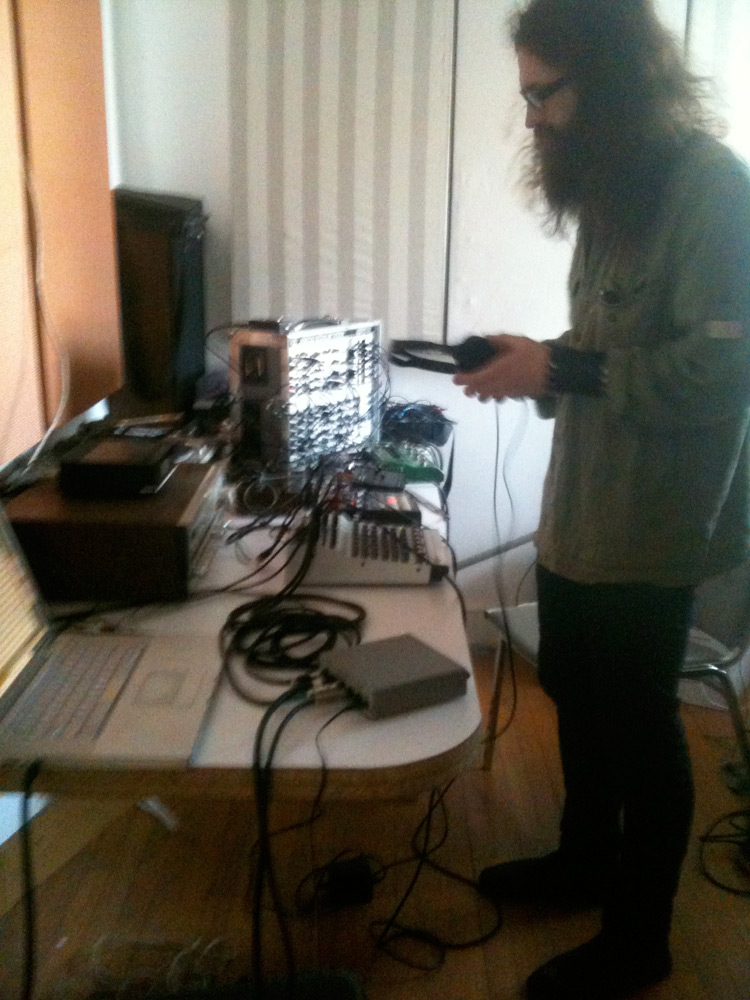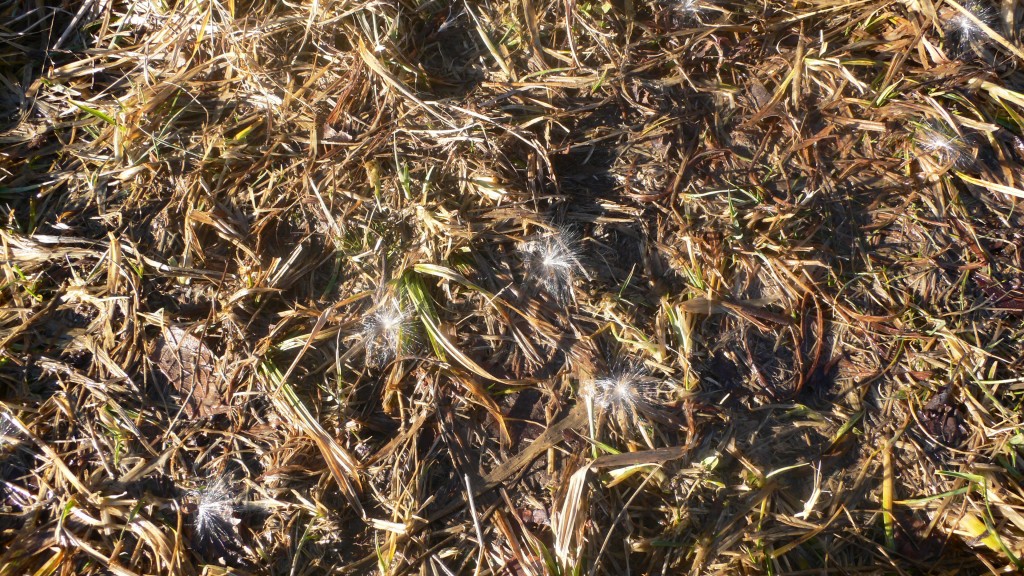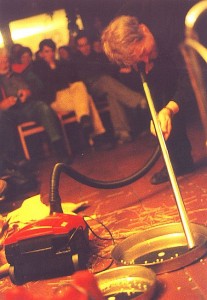‘Remote Viewing’ is a slide program, developed for radio: The articulation of Maximilian Goldfarb’s text is accompanied by improvised sounds, performed by Crazed, which is the electronic sound outfit of Jack Schoonover and Maximillian Hamel. As a visual archive escaping traditional representation, we perform excerpts from a text that conveys a hallucinatory urbanism, interconnected anatomies, and the mechanics of everyday apparitions.

Tag Archives: Wave Farm/WGXC-90.7FM
Show 551: Seth Cluett’s The Exercise of Memory (Wave Farm WGXC 90.7-FM)
Writes Cluett, “I grew up rurally in the foothills of the Berkshire mountains on the eastern border of New York state and the states of Vermont and Massachusetts. Though I was at the periphery of three minor cities, each had colleges and local radio programming, leaving me at the center of the overlapping zones of their respective radio broadcast regions. When the whether would shift, the access would change; the pattern of expected scheduled programming was tethered to the randomness of the weather within the loose pattern of the four seasons. The material presented in this work represents common sound memories to each of the places I’ve lived in the last 7 years: the city of Troy in the state of New York, the city of Paris in France, the borough of Hightstown in central New Jersey, and the town of Oxford in the southwest corner of Ohio. Sirens, bells, rain, snow, wind, birds, footsteps, and traffic represent substantial areas of overlap between the soundscapes of each home. The work ebbs and flows between these geographic markers with the randomness of weather, finding pattern in the blurry boundaries of memory recorded as sound.”
Show 526: Videofreex (Wave Farm/WGXC)
Listen to the story of the Videofreex, from some of the original members of the video collective that began in the late 1960s in New York City. After meeting at Woodstock, the video art group was hired by CBS to do “60 Minutes”-meets-“Saturday Night Live” show that gets one pilot made. After that pilot, several CBS executives are fired. But Abbie Hoffman hires members of the group to write the pirate broadcasting chapter in “Steal This Book” and pays them with video transmission equipment. So the Videofreex head upstate to Greene County and start Lanesville TV, what might be America’s first pirate television station. Interviews are excerpted here from many sources: Skip Blumberg and Parry Teasdale speak at a recent Dorsky Museum talk about the group, broadcast by Wave Farm Radio. Jon Nealon, the filmmaker at the helm of the just-released documentary, “Here Come the Videofreex!” is also interviewed here, as is Andrew Ingall, the curator of the show about the group that is at the Dorsky Museum through July 2015. Videofreex are represented by Video Data Bank in Chicago.
Show 501: William Burroughs and Body Broadcasting (Wave Farm/WGXC)
American novelist, short story writer, essayist, painter, and spoken word performer William S. Burroughs is sonically explored in this episode. Born 100 years ago and died in 1997, Burroughs’ cut-up period — the mid-1950s to mid-1960s — is explored here, with a special focus on Burroughs use of bodies and diseases as transmission metaphors. Ronald De Feo wrote in Modern Occasions in 1972, “in ‘The Ticket that Exploded,’ he scatters among his short-winded and repetitive fantasies a metaphysics, an eschatology, a theory of possession by demonic tape recorders, a theory of sexuality, an assault on advertising as a form of brainwashing, the usual quota of flashbulb-and-firecracker sodomies, and some suggestions for mind-changing party games.” This show cuts-up Burroughs’ words and mixes them with other odd sounds and stories. Two in particular about the body as transmitter or receiver. The episode samples Lucille Ball, talking about her molar radio, and an episode of the 1960s American television show “Gilligan’s Island” in which the title character’s tooth becomes a radio receiver. Then radio artist Anna Friz talks about whale radio, and other sonic signals sent by underwater creatures, from a talk in Toronto, Canada at the “Trans-X Transmission Art Symposium.” Burroughs words on disease, bodies, and transmission are cut-up throughout the show. Produced by Tom Roe from Wave Farm and WGXC in New York, in the United States.
Show 477: Morton Feldman Says, Robert Ashley
“Morton Feldman Says, Robert Ashley,” from April 9, 2011 Wave Farm/WGXC broadcast. Performed by Bill Hellermann and Max Goldfarb. Hellermann and Goldfarb perform Robert Ashley’s “Morton Feldman Says” live in WGXC 90.7-FM’s Hudson Studio on April 9, 2011. Wave Farm Executive Director Galen Joseph-Hunter introduces the broadcast, and asks a few questions afterward. Click here to download the audio file. (28:11)
Show 461: NRRF B Radio presents: Voyage to the Forbidden Planet
NRRF is a collaborative effort to make unlicensed neighborhood radio art. For the B Radio iteration, the core group of noisemakers consists of Jonny Farrow, Anna Friz, Steve Germana, Jeff Kolar, Peter Speer, with Sarah Knudtson (documentation and props wrangling).
B Radio is a series of long-form radio shows mashing b-list genres with radio art. Each B Radio episode features a theme to structure the improvisational nature of the shows, though tangents are frequent and encouraged. It’s live radio, streamed, with special guests and live audience.
Recorded from a live pirate and translocal radio session at the Experimental Sound Studio (Chicago) and Deep Wireless Festival of Radio and Transmission Art (Toronto) on May 3, 2013.
Show 452: Talking Sounds by Hans Schüttler (Wave Farm/WGXC)
German composer Hans Schüttler creates live radio dramas, and was recently in New York City for a workshop and performance at Harvestworks as part of 2013 New York Electronic Art Festival. Hans Tammen from Harvestworks put together this audio tour of Schüttler’s work. It includes excerpts of “Death of an Underwater Diver” and others. This show was produced for Wave Farm‘s WGXC in New York.
Hans Schüttler produces radio dramas for German public radio WDR, DeutschlandRadio Berlin, NDR, and others. He has produced radio dramas for writers such as Günther Eich and Vladimir Grossman, but also his own productions in various genres. As an audio artist he also created works for theater productions and audio books. Schüttler studied piano with Nicolai Posnjakow, and currently teaches at the Universities of Kassel, Rostock and Halle. As a pianist and composer he worked together with a wide range of artists such as Manos Tsangaris, Dieter Schnebel, Barry Guy, Dror Feiler, Anthony Braxton, Howard Johnson, Jay Oliver, Jimmy Carl Black, Dangaa Khosbayar Hosoo, Ge Suk Yeo, Kuyn Dong Yeo.
Download an mp3 of the show here.
Show 428: Everything is Eel Transmission by Sam Sebren from free103point9/WGXC

Sam Sebren and Liz LoGiudice to bring you a glimpse into the transmission of Anguilla rostrata, aka the American eel. Sebren and LoGiudice trace the eel’s story from the Hudson River to the Caribbean, sometimes by way of Europe and the Pacific. Sebren and LoGiudice look at the American Eel Project’s Hudson River Estuary Program. Teams of scientists, students, and over 200 community volunteers monitor and count glass eels at 12 HREP sample stream locations along the Hudson River in New York State in the United States.
Each year, glass eels – the tiny, transparent young fish – navigate the Atlantic Ocean all the way from the Sargasso Sea to the rivers along the East Coast. Every March and April, these young fish migrate into the rivers and freshwater streams, where they mature for 20 years or more before returning to the Sargasso Sea to mate and die. This episode of “Radia” tracks their progress in the Hudson River, and around the world. The entire show serves as a metaphor for the “Radia” stations and weekly transmission.
Liz LoGiudice is an environmental educator and eel devotee who helps to coordinate the Hudson River Eel Project in Greene County. Sam Sebren is a volunteer citizen scientist for the HREP American Eel Research project, and a multidisciplinary artist who began his career in the East Village New York arts scene in the 1980s. A prolific maker, Sebren’s visual works take form in installation, collage, painting, photography, video, and public works. His sound-based works have ties to noise and no-genre music (Menlo Park Recordings). Sebren also uses the medium of radio to activate dialogue around ecological and social justice issues impacting New York’s upper Hudson Valley. LoGiudice and Sebren collected and edited audio from various eel experts and volunteers of all ages at various locations during the 2012 eel counting season. For more information about the Hudson River Estuary Program, or to volunteer, go here: http://www.dec.ny.gov/lands/49580.html
This episode was produced through the Wave Farm studios at WGXC 90.7-FM in New York, in the United States.
Show 405: Sound Effects Show from free103point9
From free103point9 in upstate New York, a story of sound effects, subverting a documentary-style radio show with bits of radio theatre created entirely of sound effects. Foley effects in films, and live theatre and radio sound effects are explored. Also music from Spike Jones (“The Sound Effects Man”), Rufe Davis (“I’m a Sound Effects Man”), and Dymaxion (“The Haunted Radio”), plus fake commercials, and excerpts of pop songs (“Paper Planes” by M.I.A. and “Pop Life” from Prince) and more. (27:58) Audio file:
http://data.free103point9.org/r/q5/46/23/Radia_s29_n405_free103point9_WGXC_Sound_Effects.mp3
free103point9 is a non-profit arts organization defining and cultivating the genre Transmission Arts by promoting artists and works with, for, and about the electromagnetic spectrum — the airwaves. Transmission arts programming from free103point9 Online Radio airs every Saturday and every night from midnight to 6 a.m. on WGXC 90.7-FM, a 3300-watt radio station in the Hudson Valley in New York State in the United States.
Show 381: by Jeremy Kelley

Jeremy Kelly is a noise musician based in Hudson, New York. He uses
radio feedback to create psychedelic noise collages.


